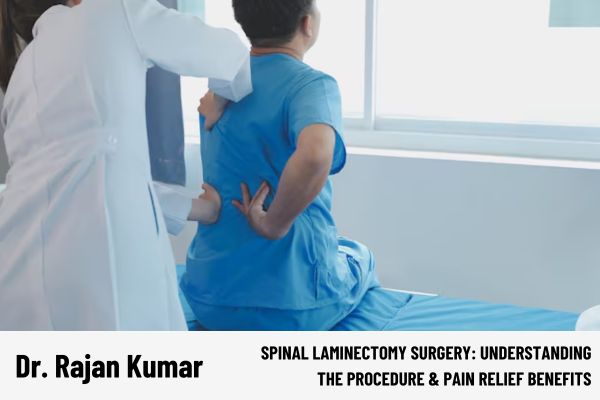Spinal Laminectomy Surgery: What to Expect and How It Can Relieve Back Pain with Dr. Rajan Kumar
Chronic back pain, especially when caused by conditions like spinal stenosis, herniated discs, or nerve compression, can significantly affect your quality of life. For many people suffering from severe and persistent back pain, spinal laminectomy surgery offers a highly effective treatment option to alleviate pain and improve mobility.
Dr. Rajan Kumar, a renowned spine specialist, breaks down everything you need to know about spinal laminectomy surgery—what it involves, how it can provide lasting relief from chronic back pain, and what to expect during recovery.
What is Spinal Laminectomy Surgery?
Spinal laminectomy is a minimally invasive surgical procedure aimed at relieving pressure on the spinal cord or nerves. The procedure involves the removal of a portion of the vertebra called the lamina, which is the back part of the vertebra that covers the spinal canal. By creating more space in the spinal canal, the surgery reduces pressure on the spinal cord or nerves, which in turn alleviates symptoms such as pain, numbness, and weakness.
Conditions Treated with Spinal Laminectomy:
Spinal laminectomy is commonly used to treat conditions that cause narrowing of the spinal canal (spinal stenosis), herniated discs, or nerve compression. These include:
- Spinal Stenosis: A narrowing of the spinal canal, often caused by aging or degenerative changes.
- Herniated Discs: Discs that have slipped out of place, putting pressure on the surrounding nerves.
- Degenerative Disc Disease: Breakdown of the spinal discs, leading to instability and pain.
- Spondylolisthesis: When one vertebra slips over another, causing nerve compression.
How Spinal Laminectomy Surgery Works
During the procedure, Dr. Rajan Kumar performs the following steps:
- Incision: A small incision is made in the back, directly over the affected area of the spine.
- Muscle Retraction: The muscles and tissues surrounding the spine are gently moved aside to access the vertebrae.
- Lamina Removal: The lamina (or part of the lamina) is removed to relieve pressure on the spinal cord or nerves.
- Closing the Incision: After the procedure is completed, the incision is closed with stitches, and the area is bandaged.
Spinal laminectomy is often performed under general anesthesia, and the surgery typically takes about 1 to 2 hours to complete.
Recovery After Spinal Laminectomy
Recovery from spinal laminectomy varies depending on the individual and the extent of the surgery. Here’s what you can expect during the recovery process:
- Hospital Stay: Most patients stay in the hospital for 1 to 3 days for observation and initial recovery.
- Pain Management: Pain medications are prescribed to manage post-surgery discomfort.
- Physical Therapy: After the initial recovery phase, physical therapy is recommended to strengthen muscles, improve flexibility, and restore normal movement.
- Activity Limitations: Patients are usually advised to avoid bending, lifting heavy objects, and strenuous activities for several weeks to ensure proper healing.
Most patients start feeling better within 6 to 8 weeks, with continued improvement over the following months.
Benefits of Spinal Laminectomy Surgery
The main benefit of spinal laminectomy is its ability to relieve pressure on the nerves and spinal cord. The procedure offers several advantages, including:
- Pain Relief: It helps eliminate the chronic pain caused by nerve compression.
- Improved Mobility: Many patients experience improved mobility and the ability to resume normal activities.
- Long-Term Relief: Spinal laminectomy can provide lasting relief from pain and other symptoms associated with spinal conditions, allowing patients to live more active, pain-free lives.
- Minimally Invasive: The procedure is minimally invasive, meaning smaller incisions and a quicker recovery time compared to traditional open surgery.
Risks and Considerations
As with any surgery, spinal laminectomy comes with a few risks, including:
- Infection at the surgical site
- Blood clots or bleeding
- Nerve damage, although this is rare
- Spinal instability, requiring further intervention
However, these risks are generally low, and the procedure is considered safe for most patients in good health.
Is Spinal Laminectomy Right for You?
If you’re suffering from chronic back pain and have not found relief through non-surgical treatments, spinal laminectomy surgery could be a great option. Dr. Rajan Kumar can help you evaluate your condition and determine whether this procedure is the right choice for you.
A thorough consultation with a spine specialist will help ensure that spinal laminectomy is the best course of action based on your symptoms, health history, and specific condition.
Conclusion
Spinal laminectomy is an effective and minimally invasive surgery that can bring lasting relief to patients suffering from chronic back pain due to spinal stenosis, herniated discs, or other related conditions. By following the expert guidance of Dr. Rajan Kumar, you can understand the full scope of the surgery, its benefits, and the recovery process. With proper treatment, you can look forward to a pain-free life and improved quality of living. If you’re struggling with chronic back pain, don’t hesitate to reach out to Dr. Rajan Kumar for a consultation. Take the first step toward reclaiming your health and well-being today.

